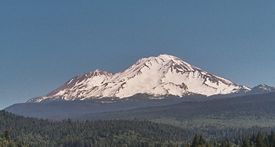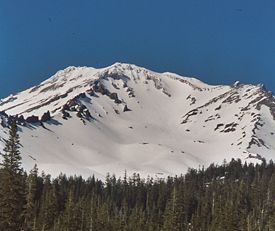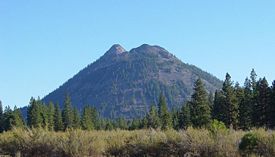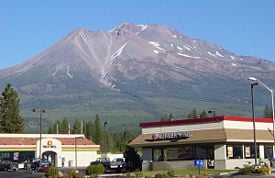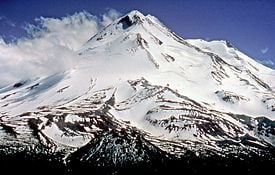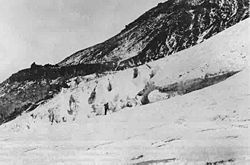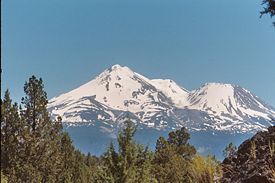Difference between revisions of "Mount Shasta" - New World Encyclopedia
Mary Anglin (talk | contribs) |
Rosie Tanabe (talk | contribs) |
||
| (24 intermediate revisions by 6 users not shown) | |||
| Line 1: | Line 1: | ||
| − | {{ | + | {{Copyedited}}{{Approved}}{{Submitted}}{{Images OK}}{{Paid}} |
{{Infobox Mountain | {{Infobox Mountain | ||
| Name = Mount Shasta | | Name = Mount Shasta | ||
| Photo = MtShasta aerial.JPG | | Photo = MtShasta aerial.JPG | ||
| − | | Caption= Aerial view of Mount Shasta from the west | + | | Caption= Aerial view of '''Mount Shasta''' from the west |
| − | | Elevation = 14,179 | + | | Elevation = 14,179 feet (4,322 meters)<ref name = height>The height of Mount Shasta has traditionally been given as 14,161 feet (or 14,162 feet)—however, the most recent height listed by the U.S. government is 14,179 feet. Elevations on "USGS quad maps" are not the most up to date elevations, because they are only updated at 20 to 30 year intervals. To find the most recent elevation of Mount Shasta, visit the [http://www.ngs.noaa.gov National Geodetic Survey.] The elevation given of 14,179 feet is the latest and most accurate elevation.</ref> |
| − | | Location = [[California|California, | + | | Location = [[California|California, United States]] |
| Range = [[Cascade Range|Cascades]] | | Range = [[Cascade Range|Cascades]] | ||
| − | | Prominence = 9,822 | + | | Prominence = 9,822 feet (2,994 meters), ranked 97th |
| − | | Coordinates = {{coor | + | | Coordinates = {{coor dm|41|24.3|N|122|11.4|W|type:mountain_region:US}} |
| Topographic map = [[United States Geological Survey|USGS]] Mount Shasta | | Topographic map = [[United States Geological Survey|USGS]] Mount Shasta | ||
| Type = [[Stratovolcano]] | | Type = [[Stratovolcano]] | ||
| Last eruption = 1786 | | Last eruption = 1786 | ||
| Age=~ 593 kyr | | Age=~ 593 kyr | ||
| − | | First ascent = 1854 by E.D. Pearce and party | + | | First ascent = 1854 by E. D. Pearce and party |
| Easiest route = rock/ice | | Easiest route = rock/ice | ||
}} | }} | ||
| − | '''Mount Shasta''', a 14,179-foot (4,322 | + | '''Mount Shasta''', a 14,179-foot (4,322-meter)<ref name = height /> [[stratovolcano]], is the second-highest peak in the [[Cascade Range]] and the fifth highest peak in [[California]]. It is a member in the Cascade Volcanic Arc, located in Siskiyou County, and has an estimated volume of 108 cubic miles (450 cubic kilometers), making it the most voluminous stratovolcano of the Cascades.<ref>Elizabeth L. Orr and William N. Orr, ''Geology of the Pacific Northwest'' (New York: The McGraw-Hill Companies, 1996, ISBN 0070480184), p. 115.</ref> Physically unconnected to any nearby mountain and rising abruptly from miles of level ground which encircle it, Mount Shasta stands some 10,000 feet (3,000 meters) above the surrounding area. |
| − | Shasta was memorably described by the poet Joaquin Miller: "Lonely as God, and white as a winter moon, Mount Shasta starts up sudden and solitary from the heart of the great black forests of Northern California."<ref name = Miller> | + | Mount Shasta is home to pristine mountain [[lake]]s, [[river]]s and [[forest]]s. There are miles of backcountry trails filled with diverse flora and fauna, providing enjoyment to the thousands each year who visit. A truly majestic mountain, it is considered a holy site by the [[Native American]]s, and has been a site for spiritual pilgrims over the centuries. |
| + | {{toc}} | ||
| + | Shasta was memorably described by the poet Joaquin Miller; | ||
| + | :"Lonely as God, and white as a winter moon, Mount Shasta starts up sudden and solitary from the heart of the great black forests of Northern California."<ref name = Miller>Joaquin Miller (1873), ''Life Amongst the Modocs: Unwritten History'' (Berkeley, CA: Heyday Books, 1996, ISBN 0930588797).</ref> | ||
| + | |||
| + | == Overview == | ||
| + | Mount Shasta is considered one of California's most significant and beloved landmarks. It has attracted researchers from all over the world studying the [[zoology]], [[botany]], [[geology]], [[history]], and [[culture]] of the mountain and its surrounding area. It provides a unique environment for study due to its high elevations and extreme temperatures. Botanists come seeking insights into the geographic distribution and evolution of the plant kingdom. Scientists such as [[Josiah Whitney]] and [[Joseph Silas Diller]] have studied the mountain extensively for clues into petrology, [[glaciation]], [[mineralogy]], [[gravity]], radiometric dating of rocks, ancient avalanches, volcanic hazard potentials, [[earthquake]]s, and geothermal activity. | ||
| + | |||
| + | Several well–known conservationists and writers, such as [[Joaquin Miller]] and [[John Muir]] spent time there and attested to its beauty. Miller's initial fame came through his Mount Shasta writings. Muir, who founded the [[Sierra Club]] and was the inspiration behind the creation of the national park system, climbed Mount Shasta three times from 1874-1875. | ||
| + | |||
| + | Other areas of study have been conducted based upon the mountain. The [[Native American]] traditions and languages of Mount Shasta have been studied as part of a worldwide pattern of language and culture. Shasta even provides a backdrop for the study of international politics as [[Mexico]], [[United Kingdom|Britain]] and the [[United States]] laid claims to the region. Its history provides a treasure store of important information in the studies of science, history, religion and social sciences. | ||
| + | |||
| + | The nearby College of the Siskiyous has developed a collection of hundreds of books, articles, manuscripts, and audio-visual materials pertaining to Mount Shasta. A special research collection is available to visiting researchers, educators, and students providing materials for the study of geology, weather, ecology, flora, fauna, Native Americans, folklore, history, art, literature, outdoor recreation, and geography.<ref> [http://www.siskiyous.edu/shasta/us/goals.htm About the Mount Shasta Project], ''Mount Shasta Companion''. Retrieved May 19, 2007.</ref> | ||
==Geology== | ==Geology== | ||
| − | [[image:Shasta from south.jpg|thumb| | + | [[image:Shasta from south.jpg|thumb|275px|right|Shasta from the south, taken near Dunsmuir, California. Shastina is the satellite cone on the left.]] |
| − | Mount Shasta consists of four overlapping [[Volcano|volcanic]] cones which have built a complex shape, including the main summit and the prominent satellite cone of 12,330 feet (3,758 | + | Mount Shasta consists of four overlapping [[Volcano|volcanic]] cones which have built a complex shape, including the main summit and the prominent satellite cone of 12,330 feet (3,758 meters), ''Shastina'', which has a visibly conical form. Mount Shasta's surface is relatively free of deep glacial [[erosion]] except, paradoxically, for its south side where ''Sergeants Ridge'' runs parallel to the U-shaped valley, ''Avalanche Gulch''. This is the largest glacial valley on the volcano, although it does not presently contain a [[glacier]]. |
| − | The U.S. Geological Survey recognizes seven glaciers on Mount Shasta, although Rhodes (1987) suggests there are ten extant glaciers. The seven glaciers recognized by the USGS are | + | The U.S. Geological Survey recognizes seven glaciers on Mount Shasta, although Rhodes (1987) suggests there are ten extant glaciers. The seven glaciers recognized by the USGS are Whitney Glacier, Bolam Glacier, Hotlum Glacier, Wintun Glacier, Watkins Glacier, Konwakiton Glacier, and Mud Creek Glacier. The additional glaciers recognized by Rhodes are Upper Wintun Glacier, Chicago Glacier, and Olberman Glacier (Rhodes 1987; Biles 1989). Whitney is the longest glacier and Hotlum is the most voluminous glacier in the state of [[California]]. Three of the smaller named glaciers occupy cirques, which are amphitheatre-like valleys of glacial origin formed by glacial erosion at the head of the glacier, and are above 11,000 feet (3,300 meters) on the south and southeast sides, including the Watkins, Konwakiton, and Mud Creek Glaciers. |
| − | [[ | + | There are many buried glacial scars on the mountain which were created in recent glacial periods ("ice ages") of the present [[Wisconsin glaciation|Wisconsinian glaciation]]. Most have since been filled-in with [[andesite]] [[lava]], [[pyroclastic flow]]s, and [[Scree|talus]] from lava domes. Shastina, by comparison, has a fully intact summit crater indicating that Shastina developed after the last [[ice age]]. |
| − | + | About 593,000 years ago [[andesite|andesitic]] lavas erupted in what is now Mount Shasta's western flank near McBride Spring. Over time, an ancestral Shasta [[stratovolcano]] was built to a large, but unknown height; sometime between 300,000 to 360,000 years ago the entire north side of the [[volcano]] collapsed, creating an enormous landslide or [[debris avalanche]], 6.5 cubic miles (27 cubic kilometers) in volume. The slide flowed northwestward into Shasta Valley where the Shasta River now cuts through the 28-mile-long (45-kilometer) flow. Only a small remnant of the older edifice remains on the west side of the stratovolcano. | |
| − | + | [[image:Avalanche Gulch Shasta.jpg|thumb|275px|left|Avalanche Gulch on Mt. Shasta. Sergeants Ridge is at center right.]] | |
| − | + | What remains of the oldest of Shasta's four cones is exposed at Sergeants Ridge on the south side of the mountain. Lavas from the Sergeants Ridge vent cover the Everitt Hill shield at Shasta's southern foot. The last lavas to erupt from the vent were [[hornblende]]-[[pyroxene]] andesites with a hornblende [[dacite]] dome at its summit. Glacial erosion has since modified its shape. | |
| − | + | The next cone to form is exposed south of Shasta's current summit and is called Misery Hill. It was formed 15,000 to 20,000 years ago from pyroxene andesite flows and has since been intruded by a hornblende dacite dome. | |
| − | + | [[image:Black Butte from Weed, California-750px.jpg|thumb|275px|Black Butte from Weed, California]] | |
| + | Since then the Shastina cone has been built by mostly pyroxene andesite lava flows. Some 9,500 years ago, these flows reached about 6.8 miles (11 kilometers) south and three miles north of the area now occupied by nearby [[Black Butte]]. The last eruptions formed Shastina's present summit about a hundred years later. But before that, Shastina, along with the then forming Black Butte dacite plug dome (a volcano with steep sides formed from pasty lava "squeezed" out of a central vent) complex to the west, created numerous [[pyroclastic flow]]s that covered 43 square miles (110 square kilometers), including large parts of what is now Mount Shasta and Weed, California. Diller Canyon (400 feet/120 meters deep and a quarter-mile/400 meters wide) is an avalanche chute that was probably carved into Shastina's western face by these flows. | ||
| − | + | The last to form, and the highest cone, the Hotlum Cone, formed about eight thousand years ago. It is named after the Hotlum glacier on its northern face; its longest lava flow, the 500 feet (150 meters) thick Military Pass flow, extends 5.5 miles (9 kilometers) down its northwest face. Since the creation of the Hotlum Cone, a dacite dome intruded the cone and now forms the summit. The rock at the 600 feet (180 meters) wide summit crater has been extensively hydrothermally altered by sulfurous [[hot spring]]s and [[fumarole]]s. However, there are only a few examples still remaining. | |
| − | |||
| − | + | In the last eight thousand years, the Hotlum Cone has erupted at least eight or nine times. About two hundred years ago the last significant Shasta eruption came from this cone and created a pyroclastic flow, a hot [[lahar]] (mudflow), and three cold lahars, which streamed 7.5 miles (12 kilometers) down Shasta's east flank via Ash Creek. A separate hot lahar went 12 miles (19 kilometers) down Mud Creek. | |
| − | |||
| − | In the last | ||
==Volcanic hazards== | ==Volcanic hazards== | ||
| − | [[image:Diller Canyon on Mt Shastina from Weed, California-1200px.JPG|thumb|Diller Canyon on | + | [[image:Diller Canyon on Mt Shastina from Weed, California-1200px.JPG|thumb|275px|Diller Canyon on Mount Shastina from Weed, California]] |
| − | During the last 10,000 years Shasta has erupted | + | During the last 10,000 years, Shasta has, on average, erupted every eight hundred years, but in the past 4,500 years the [[volcano]] has erupted an average of every six hundred years. The last significant eruption on Shasta may have occurred two hundred years ago. |
| − | Mount Shasta can release volcanic ash, pyroclastic flows or dacite and andesite [[lava]]. Its deposits can be detected under nearby small towns | + | Mount Shasta can release volcanic ash, pyroclastic flows or dacite and andesite [[lava]]. Its deposits can be detected under nearby small towns totaling 20,000 in population. Shasta has an explosive, eruptive history. There are fumaroles on the mountain, which show that Shasta is still alive. |
The worst case scenario for an eruption is a large pyroclastic flow, such as occurred in the 1980 eruption of [[Mount Saint Helens]]. Since there is ice, such as Whitney Glacier and Mud Creek Glacier, lahars would also result. Ash would probably blow inland, perhaps as far as eastern [[Nevada]]. There is a small chance that an eruption could also be larger than has been anticipated, resulting in a collapse of the mountain, as happened at [[Mount Mazama]] in [[Oregon]], but this is of much lower probability. | The worst case scenario for an eruption is a large pyroclastic flow, such as occurred in the 1980 eruption of [[Mount Saint Helens]]. Since there is ice, such as Whitney Glacier and Mud Creek Glacier, lahars would also result. Ash would probably blow inland, perhaps as far as eastern [[Nevada]]. There is a small chance that an eruption could also be larger than has been anticipated, resulting in a collapse of the mountain, as happened at [[Mount Mazama]] in [[Oregon]], but this is of much lower probability. | ||
| − | The United States Geological Survey considers Shasta a dormant volcano which will erupt again. | + | The United States Geological Survey considers Shasta a dormant volcano which will erupt again. It is impossible to pinpoint the date of next eruption, but it is calculated that it likely will occur within the next several hundred years. |
==History== | ==History== | ||
| − | The oldest human habitation in the area dates to about | + | [[Image:MtShasta SnowCapped.jpg|thumb|left|275px|Mount Shasta]] |
| + | The oldest human habitation in the area dates to about seven thousand years ago, and by about five thousand years ago, there was substantial human habitation in the surrounding area. | ||
| − | At the time of Euro-American contact in the 1820s, the Native American tribes who lived within view of Mount Shasta included the Shasta, Okwanuchu, Modoc, Achomawi, Atsugewi, Karuk, Klamath, Wintu, and Yana tribes. | + | At the time of Euro-American contact in the 1820s, the [[Native American]] tribes who lived within view of Mount Shasta included the [[Shasta]], [[Okwanuchu]], [[Modoc]], [[Achomawi]], [[Atsugewi]], [[Karuk]], [[Klamath]], [[Wintu]], and [[Yana]] tribes. |
| − | Although perhaps first seen by Spanish explorers, the first reliably-reported sighting of Mount Shasta by a European or American was by Peter Skene Ogden (a leader of a Hudson's | + | Although perhaps first seen by Spanish explorers, the first reliably-reported sighting of Mount Shasta by a European or American was by [[Peter Skene Ogden]] (a leader of a [[Hudson Bay Company]]'s trapping brigade) in 1826. In 1827, the name "Sasty" or "Sastise" was given to nearby Mount McLoughlin by Ogden. The name was transferred to present-day Mount Shasta in 1841, partly as a result of work by the United States Exploring Expedition. |
| − | Beginning in the 1820s, Mount Shasta was a prominent landmark along what became known as the Siskiyou Trail, which runs at Mount Shasta's base. | + | Beginning in the 1820s, Mount Shasta was a prominent landmark along what became known as the Siskiyou Trail, which runs at Mount Shasta's base. The Siskiyou Trail was located on the track of an ancient trade and travel route of Native American footpaths between California's Central Valley and the [[Pacific Northwest]]. |
| − | The California Gold Rush brought the first Euro-American settlements into the area in the early 1850s, including at Yreka, California and Upper Soda Springs. | + | The California [[Gold Rush]] brought the first Euro-American settlements into the area in the early 1850s, including at Yreka, [[California]] and Upper Soda Springs. The first recorded ascent of Mount Shasta occurred in 1854 by Elias Pearce, after several earlier failed attempts. In 1856, the first women, Harriette Eddy, Mary Campbell McCloud and their party, were recorded as reaching the summit. |
| − | [[Image:King_WhitneyGlacier.jpg|thumb| | + | [[Image:King_WhitneyGlacier.jpg|thumb|right|250px|[[Clarence King]] exploring the Whitney Glacier in 1870]] |
| − | + | Whitney Glacier was the first [[glacier]] in the continental [[United States]] discovered and named. It was named for [[Josiah Whitney]], head of the California Geological Survey. By the 1860s and 1870s, Mount Shasta was the subject of scientific and literary interest. The summit was achieved, or nearly so, by [[John Muir]], Josiah Whitney, [[Clarence King]], and [[John Wesley Powell]]. In 1877, Muir wrote a dramatic popular article about an experience in which he survived an overnight blizzard on Shasta by lying in the hot sulfur springs found near the summit.<ref>John Muir, [http://www.siskiyous.edu/shasta/lit/mui/jmuir13.htm “Snow-Storm on Mount Shasta,”] in ''Harper's New Monthly Magazine'' (September 1877). Retrieved May 18, 2016.</ref> | |
| − | In the early | + | The 1887 completion of the Central Pacific Railroad, built along the line of the Siskiyou Trail between California and Oregon, brought a substantial increase in [[tourism]], lumbering, and population into the area around Mount Shasta. Early resorts and hotels, such as Shasta Springs, grew up along the Siskiyou Trail around Mount Shasta, catering to these early adventuresome tourists and mountaineers. |
| + | |||
| + | In the early twentieth century, the [[Pacific Highway]] followed the track of the Siskiyou Trail to the base of Mount Shasta, leading to still more access to the mountain. Today's version of the Siskiyou Trail, Interstate 5, brings thousands of people a year to Mount Shasta. | ||
Today, the area remains one of California's premiere tourist destinations, attracting travelers from around the world. | Today, the area remains one of California's premiere tourist destinations, attracting travelers from around the world. | ||
==Religion== | ==Religion== | ||
| − | [[image:Shasta_pix_3.JPG|thumb| | + | [[image:Shasta_pix_3.JPG|thumb|275px|right|Shasta and Shastina from the north, near Pluto's Caves]] |
| − | The lore of some of the [[Native Americans in the United States|Native Americans]] in the area held that Shasta is inhabited by the spirit chief Skell who descended from heaven to the mountain's summit. | + | Many faiths have been attracted to Shasta over the years—more than to any other [[Cascade Range|Cascade]] volcano. Mount Shasta and Dunsmuir, small towns near Shasta's western base, are focal points for many of these, which range from a [[Buddhism|Buddhist]] monastery (Shasta Abbey, founded by Houn Jiyu-Kennett in 1971) to modern-day Native American rituals. As reported in the documentary ''In The Light of Reverence'' a group of Native Americans from the McCloud River area practice rituals on the mountain.<ref>[http://www.pbs.org/pov/pov2001/inthelightofreverence/thefilm.html P.O.V. - In The Light of Reverence,] Public Broadcasting System (PBS). Retrieved June 26, 2007.</ref> |
| + | |||
| + | The lore of some of the [[Native Americans in the United States|Native Americans]] in the area held that Shasta is inhabited by the spirit-chief Skell, who descended from heaven to the mountain's summit. The mountain is therefore considered a sacred site. The Natives struggle with their holy site being visited by those who might not pay proper respect, and who may contaminate or disrupt the site. In 1988 the U.S. Supreme Court ruled that the disturbance of the practice of religion need not be weighed against economic benefit in determining how public lands are to be used.<ref>Christopher Jocks, [http://www.britannica.com/topic/Native-American-religion “Native American religions,”] ''Encyclopædia Britannica Online''. Retrieved May 18, 2016.</ref> | ||
| − | + | Numerous groups participate in Shasta's spiritual heritage. Some people hold that races of sentient or spiritual beings, superior to humans, live in or on Shasta, or visit the mountain, including Lemurians, Yaktayvians and Phylos. Two of the perhaps best-known among these are "I Am" Activity and [[Church Universal and Triumphant]]. | |
| − | + | The "I Am" Activity was founded by [[Guy Ballard]] in 1930. While hiking on Mt. Shasta, he claimed to have encountered a man who introduced himself as [[Count of Saint Germain|Saint Germain]], an immortal being who had lived on [[Earth]] in many embodiments before his ascension. Saint Germain told Ballard that the Ascended Masters (which included both Saint Germain and [[Jesus of Nazareth|Jesus Christ]]) wished to communicate to the Western world instruction on the "Great Laws of Life." Over their lifetimes, the Ballards recorded immense amounts of information which they claimed were given to them by the “Ascended Masters.” | |
| − | + | Mark and [[Elizabeth Clare Prophet]]'s [[Church Universal and Triumphant]] (begun in the 1950s) is an off-shoot of the original “I Am” movement. | |
==Climbing== | ==Climbing== | ||
| − | The summer climbing season runs from late April until October, although many attempts are made in the winter. Avalanche Gulch | + | The summer climbing season on Mount Shasta runs from late April until October, although many attempts are made in the winter. ''Avalanche Gulch Route'' is one of the most popular and climbed routes in the United States with an estimated 15,000 climbers attempting the summit annually. With 17 established routes, each with variations, there is climbing available for beginners as well as advanced mountaineers. In winter, ''Sargent's Ridge'' and ''Cassaval Ridge'' become the most traveled routes. The types of climbs include mountaineering, rock & ice, and backpacking. The terrain depends on the route taken and varies between loose volcanic talus, rock and ice, snow, and glaciers. The climb to Shasta's peak can be a difficult hike, an ascent of 7,000 feet over ice, snow and rock. The thin air at 14,000 feet makes the physical exertion even tougher. However, the biggest problem is the weather. According to the U.S. Forest Service, about half of those who try don't make it, with bad weather being the number one preventive factor. |
| − | |||
| − | |||
| − | |||
| − | |||
| − | |||
| − | |||
| − | |||
| − | |||
| − | |||
| − | |||
| − | |||
| − | |||
| − | |||
| − | |||
==Notes== | ==Notes== | ||
| − | <div class="references-small | + | <div class="references-small"> |
<references/> | <references/> | ||
</div> | </div> | ||
==Sources and Further Reading== | ==Sources and Further Reading== | ||
| − | * | + | * Harris, Stephen L. ''Fire Mountains of the West: The Cascade and Mono Lake''. Mountain Press Pub. Co., 2005. ISBN 087842511X |
| − | * | + | * Miller, Joaquin. ''Life Amongst the Modocs: Unwritten History''. Berkeley, CA: Heyday Books, 1996. ISBN 0930588797 |
| − | * Wood, Charles Arthur | + | * Orr, Elizabeth L., and William N. Orr. ''Geology of the Pacific Northwest''. New York: The McGraw-Hill Companies, 1996. ISBN 0070480184 |
| − | + | * Selters, Andrew and Michael Zanger. ''The Mt. Shasta Book: A Guide to Hiking, Climbing, Skiing, and Exploring the Mountain and Surrounding''. Wilderness Press, 2006. ISBN 089997404X | |
| − | + | * Wood, Charles Arthur and Juergen Kienle. ''Volcanoes of North America: United States and Canada''. New York: Cambridge University Press, 1992. ISBN 052143811X | |
| − | |||
| − | |||
| − | |||
| − | |||
| − | |||
| − | |||
| − | |||
| − | |||
| − | |||
| − | |||
| − | |||
| − | |||
| − | |||
| − | |||
==External links== | ==External links== | ||
| − | + | All links retrieved November 10, 2022. | |
| − | |||
| − | |||
| − | |||
| − | |||
| − | |||
| − | |||
| − | |||
| − | |||
| − | |||
| − | |||
| − | |||
| − | + | * [http://www.siskiyous.edu/library/Shasta/index.htm The Mount Shasta Collection] – College of the Siskiyous Library | |
| + | * [http://www.summitpost.org/show/mountain_link.pl/mountain_id/2 Mount Shasta] at Summit Post | ||
| + | * [http://www.peakbagger.com/peak.aspx?pid=2477 Mount Shasta] at Peak Bagger | ||
| − | |||
| − | + | {{credit|Mount_Shasta|111655204|I_AM_Activity|130271846}} | |
| − | |||
| − | |||
| − | |||
| − | |||
| − | |||
| − | |||
| − | |||
| − | |||
| − | |||
| − | + | [[Category:Geography]] | |
| + | [[Category:United States]] | ||
| + | [[Category:Mountains]] | ||
Latest revision as of 17:45, 10 November 2022
| Mount Shasta | |
|---|---|
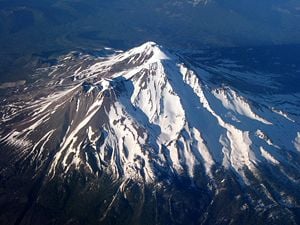 Aerial view of Mount Shasta from the west | |
| Elevation | 14,179 feet (4,322 meters)[1] |
| Location | California, United States |
| Mountain range | Cascades |
| Prominence | 9,822 feet (2,994 meters), ranked 97th |
| Geographic coordinates | 41°24.3′N 122°11.4′W |
| Topographic map | USGS Mount Shasta |
| Type | Stratovolcano |
| Geologic time scale | ~ 593 kyr |
| Last eruption | 1786 |
| First ascent | 1854 by E. D. Pearce and party |
| Easiest Climbing route | rock/ice |
Mount Shasta, a 14,179-foot (4,322-meter)[1] stratovolcano, is the second-highest peak in the Cascade Range and the fifth highest peak in California. It is a member in the Cascade Volcanic Arc, located in Siskiyou County, and has an estimated volume of 108 cubic miles (450 cubic kilometers), making it the most voluminous stratovolcano of the Cascades.[2] Physically unconnected to any nearby mountain and rising abruptly from miles of level ground which encircle it, Mount Shasta stands some 10,000 feet (3,000 meters) above the surrounding area.
Mount Shasta is home to pristine mountain lakes, rivers and forests. There are miles of backcountry trails filled with diverse flora and fauna, providing enjoyment to the thousands each year who visit. A truly majestic mountain, it is considered a holy site by the Native Americans, and has been a site for spiritual pilgrims over the centuries.
Shasta was memorably described by the poet Joaquin Miller;
- "Lonely as God, and white as a winter moon, Mount Shasta starts up sudden and solitary from the heart of the great black forests of Northern California."[3]
Overview
Mount Shasta is considered one of California's most significant and beloved landmarks. It has attracted researchers from all over the world studying the zoology, botany, geology, history, and culture of the mountain and its surrounding area. It provides a unique environment for study due to its high elevations and extreme temperatures. Botanists come seeking insights into the geographic distribution and evolution of the plant kingdom. Scientists such as Josiah Whitney and Joseph Silas Diller have studied the mountain extensively for clues into petrology, glaciation, mineralogy, gravity, radiometric dating of rocks, ancient avalanches, volcanic hazard potentials, earthquakes, and geothermal activity.
Several well–known conservationists and writers, such as Joaquin Miller and John Muir spent time there and attested to its beauty. Miller's initial fame came through his Mount Shasta writings. Muir, who founded the Sierra Club and was the inspiration behind the creation of the national park system, climbed Mount Shasta three times from 1874-1875.
Other areas of study have been conducted based upon the mountain. The Native American traditions and languages of Mount Shasta have been studied as part of a worldwide pattern of language and culture. Shasta even provides a backdrop for the study of international politics as Mexico, Britain and the United States laid claims to the region. Its history provides a treasure store of important information in the studies of science, history, religion and social sciences.
The nearby College of the Siskiyous has developed a collection of hundreds of books, articles, manuscripts, and audio-visual materials pertaining to Mount Shasta. A special research collection is available to visiting researchers, educators, and students providing materials for the study of geology, weather, ecology, flora, fauna, Native Americans, folklore, history, art, literature, outdoor recreation, and geography.[4]
Geology
Mount Shasta consists of four overlapping volcanic cones which have built a complex shape, including the main summit and the prominent satellite cone of 12,330 feet (3,758 meters), Shastina, which has a visibly conical form. Mount Shasta's surface is relatively free of deep glacial erosion except, paradoxically, for its south side where Sergeants Ridge runs parallel to the U-shaped valley, Avalanche Gulch. This is the largest glacial valley on the volcano, although it does not presently contain a glacier.
The U.S. Geological Survey recognizes seven glaciers on Mount Shasta, although Rhodes (1987) suggests there are ten extant glaciers. The seven glaciers recognized by the USGS are Whitney Glacier, Bolam Glacier, Hotlum Glacier, Wintun Glacier, Watkins Glacier, Konwakiton Glacier, and Mud Creek Glacier. The additional glaciers recognized by Rhodes are Upper Wintun Glacier, Chicago Glacier, and Olberman Glacier (Rhodes 1987; Biles 1989). Whitney is the longest glacier and Hotlum is the most voluminous glacier in the state of California. Three of the smaller named glaciers occupy cirques, which are amphitheatre-like valleys of glacial origin formed by glacial erosion at the head of the glacier, and are above 11,000 feet (3,300 meters) on the south and southeast sides, including the Watkins, Konwakiton, and Mud Creek Glaciers.
There are many buried glacial scars on the mountain which were created in recent glacial periods ("ice ages") of the present Wisconsinian glaciation. Most have since been filled-in with andesite lava, pyroclastic flows, and talus from lava domes. Shastina, by comparison, has a fully intact summit crater indicating that Shastina developed after the last ice age.
About 593,000 years ago andesitic lavas erupted in what is now Mount Shasta's western flank near McBride Spring. Over time, an ancestral Shasta stratovolcano was built to a large, but unknown height; sometime between 300,000 to 360,000 years ago the entire north side of the volcano collapsed, creating an enormous landslide or debris avalanche, 6.5 cubic miles (27 cubic kilometers) in volume. The slide flowed northwestward into Shasta Valley where the Shasta River now cuts through the 28-mile-long (45-kilometer) flow. Only a small remnant of the older edifice remains on the west side of the stratovolcano.
What remains of the oldest of Shasta's four cones is exposed at Sergeants Ridge on the south side of the mountain. Lavas from the Sergeants Ridge vent cover the Everitt Hill shield at Shasta's southern foot. The last lavas to erupt from the vent were hornblende-pyroxene andesites with a hornblende dacite dome at its summit. Glacial erosion has since modified its shape.
The next cone to form is exposed south of Shasta's current summit and is called Misery Hill. It was formed 15,000 to 20,000 years ago from pyroxene andesite flows and has since been intruded by a hornblende dacite dome.
Since then the Shastina cone has been built by mostly pyroxene andesite lava flows. Some 9,500 years ago, these flows reached about 6.8 miles (11 kilometers) south and three miles north of the area now occupied by nearby Black Butte. The last eruptions formed Shastina's present summit about a hundred years later. But before that, Shastina, along with the then forming Black Butte dacite plug dome (a volcano with steep sides formed from pasty lava "squeezed" out of a central vent) complex to the west, created numerous pyroclastic flows that covered 43 square miles (110 square kilometers), including large parts of what is now Mount Shasta and Weed, California. Diller Canyon (400 feet/120 meters deep and a quarter-mile/400 meters wide) is an avalanche chute that was probably carved into Shastina's western face by these flows.
The last to form, and the highest cone, the Hotlum Cone, formed about eight thousand years ago. It is named after the Hotlum glacier on its northern face; its longest lava flow, the 500 feet (150 meters) thick Military Pass flow, extends 5.5 miles (9 kilometers) down its northwest face. Since the creation of the Hotlum Cone, a dacite dome intruded the cone and now forms the summit. The rock at the 600 feet (180 meters) wide summit crater has been extensively hydrothermally altered by sulfurous hot springs and fumaroles. However, there are only a few examples still remaining.
In the last eight thousand years, the Hotlum Cone has erupted at least eight or nine times. About two hundred years ago the last significant Shasta eruption came from this cone and created a pyroclastic flow, a hot lahar (mudflow), and three cold lahars, which streamed 7.5 miles (12 kilometers) down Shasta's east flank via Ash Creek. A separate hot lahar went 12 miles (19 kilometers) down Mud Creek.
Volcanic hazards
During the last 10,000 years, Shasta has, on average, erupted every eight hundred years, but in the past 4,500 years the volcano has erupted an average of every six hundred years. The last significant eruption on Shasta may have occurred two hundred years ago.
Mount Shasta can release volcanic ash, pyroclastic flows or dacite and andesite lava. Its deposits can be detected under nearby small towns totaling 20,000 in population. Shasta has an explosive, eruptive history. There are fumaroles on the mountain, which show that Shasta is still alive.
The worst case scenario for an eruption is a large pyroclastic flow, such as occurred in the 1980 eruption of Mount Saint Helens. Since there is ice, such as Whitney Glacier and Mud Creek Glacier, lahars would also result. Ash would probably blow inland, perhaps as far as eastern Nevada. There is a small chance that an eruption could also be larger than has been anticipated, resulting in a collapse of the mountain, as happened at Mount Mazama in Oregon, but this is of much lower probability.
The United States Geological Survey considers Shasta a dormant volcano which will erupt again. It is impossible to pinpoint the date of next eruption, but it is calculated that it likely will occur within the next several hundred years.
History
The oldest human habitation in the area dates to about seven thousand years ago, and by about five thousand years ago, there was substantial human habitation in the surrounding area.
At the time of Euro-American contact in the 1820s, the Native American tribes who lived within view of Mount Shasta included the Shasta, Okwanuchu, Modoc, Achomawi, Atsugewi, Karuk, Klamath, Wintu, and Yana tribes.
Although perhaps first seen by Spanish explorers, the first reliably-reported sighting of Mount Shasta by a European or American was by Peter Skene Ogden (a leader of a Hudson Bay Company's trapping brigade) in 1826. In 1827, the name "Sasty" or "Sastise" was given to nearby Mount McLoughlin by Ogden. The name was transferred to present-day Mount Shasta in 1841, partly as a result of work by the United States Exploring Expedition.
Beginning in the 1820s, Mount Shasta was a prominent landmark along what became known as the Siskiyou Trail, which runs at Mount Shasta's base. The Siskiyou Trail was located on the track of an ancient trade and travel route of Native American footpaths between California's Central Valley and the Pacific Northwest.
The California Gold Rush brought the first Euro-American settlements into the area in the early 1850s, including at Yreka, California and Upper Soda Springs. The first recorded ascent of Mount Shasta occurred in 1854 by Elias Pearce, after several earlier failed attempts. In 1856, the first women, Harriette Eddy, Mary Campbell McCloud and their party, were recorded as reaching the summit.
Whitney Glacier was the first glacier in the continental United States discovered and named. It was named for Josiah Whitney, head of the California Geological Survey. By the 1860s and 1870s, Mount Shasta was the subject of scientific and literary interest. The summit was achieved, or nearly so, by John Muir, Josiah Whitney, Clarence King, and John Wesley Powell. In 1877, Muir wrote a dramatic popular article about an experience in which he survived an overnight blizzard on Shasta by lying in the hot sulfur springs found near the summit.[5]
The 1887 completion of the Central Pacific Railroad, built along the line of the Siskiyou Trail between California and Oregon, brought a substantial increase in tourism, lumbering, and population into the area around Mount Shasta. Early resorts and hotels, such as Shasta Springs, grew up along the Siskiyou Trail around Mount Shasta, catering to these early adventuresome tourists and mountaineers.
In the early twentieth century, the Pacific Highway followed the track of the Siskiyou Trail to the base of Mount Shasta, leading to still more access to the mountain. Today's version of the Siskiyou Trail, Interstate 5, brings thousands of people a year to Mount Shasta.
Today, the area remains one of California's premiere tourist destinations, attracting travelers from around the world.
Religion
Many faiths have been attracted to Shasta over the years—more than to any other Cascade volcano. Mount Shasta and Dunsmuir, small towns near Shasta's western base, are focal points for many of these, which range from a Buddhist monastery (Shasta Abbey, founded by Houn Jiyu-Kennett in 1971) to modern-day Native American rituals. As reported in the documentary In The Light of Reverence a group of Native Americans from the McCloud River area practice rituals on the mountain.[6]
The lore of some of the Native Americans in the area held that Shasta is inhabited by the spirit-chief Skell, who descended from heaven to the mountain's summit. The mountain is therefore considered a sacred site. The Natives struggle with their holy site being visited by those who might not pay proper respect, and who may contaminate or disrupt the site. In 1988 the U.S. Supreme Court ruled that the disturbance of the practice of religion need not be weighed against economic benefit in determining how public lands are to be used.[7]
Numerous groups participate in Shasta's spiritual heritage. Some people hold that races of sentient or spiritual beings, superior to humans, live in or on Shasta, or visit the mountain, including Lemurians, Yaktayvians and Phylos. Two of the perhaps best-known among these are "I Am" Activity and Church Universal and Triumphant.
The "I Am" Activity was founded by Guy Ballard in 1930. While hiking on Mt. Shasta, he claimed to have encountered a man who introduced himself as Saint Germain, an immortal being who had lived on Earth in many embodiments before his ascension. Saint Germain told Ballard that the Ascended Masters (which included both Saint Germain and Jesus Christ) wished to communicate to the Western world instruction on the "Great Laws of Life." Over their lifetimes, the Ballards recorded immense amounts of information which they claimed were given to them by the “Ascended Masters.”
Mark and Elizabeth Clare Prophet's Church Universal and Triumphant (begun in the 1950s) is an off-shoot of the original “I Am” movement.
Climbing
The summer climbing season on Mount Shasta runs from late April until October, although many attempts are made in the winter. Avalanche Gulch Route is one of the most popular and climbed routes in the United States with an estimated 15,000 climbers attempting the summit annually. With 17 established routes, each with variations, there is climbing available for beginners as well as advanced mountaineers. In winter, Sargent's Ridge and Cassaval Ridge become the most traveled routes. The types of climbs include mountaineering, rock & ice, and backpacking. The terrain depends on the route taken and varies between loose volcanic talus, rock and ice, snow, and glaciers. The climb to Shasta's peak can be a difficult hike, an ascent of 7,000 feet over ice, snow and rock. The thin air at 14,000 feet makes the physical exertion even tougher. However, the biggest problem is the weather. According to the U.S. Forest Service, about half of those who try don't make it, with bad weather being the number one preventive factor.
Notes
- ↑ 1.0 1.1 The height of Mount Shasta has traditionally been given as 14,161 feet (or 14,162 feet)—however, the most recent height listed by the U.S. government is 14,179 feet. Elevations on "USGS quad maps" are not the most up to date elevations, because they are only updated at 20 to 30 year intervals. To find the most recent elevation of Mount Shasta, visit the National Geodetic Survey. The elevation given of 14,179 feet is the latest and most accurate elevation.
- ↑ Elizabeth L. Orr and William N. Orr, Geology of the Pacific Northwest (New York: The McGraw-Hill Companies, 1996, ISBN 0070480184), p. 115.
- ↑ Joaquin Miller (1873), Life Amongst the Modocs: Unwritten History (Berkeley, CA: Heyday Books, 1996, ISBN 0930588797).
- ↑ About the Mount Shasta Project, Mount Shasta Companion. Retrieved May 19, 2007.
- ↑ John Muir, “Snow-Storm on Mount Shasta,” in Harper's New Monthly Magazine (September 1877). Retrieved May 18, 2016.
- ↑ P.O.V. - In The Light of Reverence, Public Broadcasting System (PBS). Retrieved June 26, 2007.
- ↑ Christopher Jocks, “Native American religions,” Encyclopædia Britannica Online. Retrieved May 18, 2016.
Sources and Further Reading
- Harris, Stephen L. Fire Mountains of the West: The Cascade and Mono Lake. Mountain Press Pub. Co., 2005. ISBN 087842511X
- Miller, Joaquin. Life Amongst the Modocs: Unwritten History. Berkeley, CA: Heyday Books, 1996. ISBN 0930588797
- Orr, Elizabeth L., and William N. Orr. Geology of the Pacific Northwest. New York: The McGraw-Hill Companies, 1996. ISBN 0070480184
- Selters, Andrew and Michael Zanger. The Mt. Shasta Book: A Guide to Hiking, Climbing, Skiing, and Exploring the Mountain and Surrounding. Wilderness Press, 2006. ISBN 089997404X
- Wood, Charles Arthur and Juergen Kienle. Volcanoes of North America: United States and Canada. New York: Cambridge University Press, 1992. ISBN 052143811X
External links
All links retrieved November 10, 2022.
- The Mount Shasta Collection – College of the Siskiyous Library
- Mount Shasta at Summit Post
- Mount Shasta at Peak Bagger
Credits
New World Encyclopedia writers and editors rewrote and completed the Wikipedia article in accordance with New World Encyclopedia standards. This article abides by terms of the Creative Commons CC-by-sa 3.0 License (CC-by-sa), which may be used and disseminated with proper attribution. Credit is due under the terms of this license that can reference both the New World Encyclopedia contributors and the selfless volunteer contributors of the Wikimedia Foundation. To cite this article click here for a list of acceptable citing formats.The history of earlier contributions by wikipedians is accessible to researchers here:
The history of this article since it was imported to New World Encyclopedia:
Note: Some restrictions may apply to use of individual images which are separately licensed.
